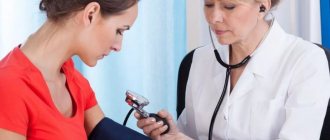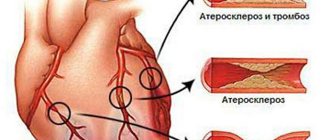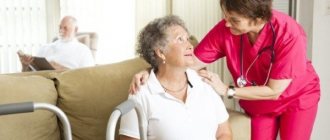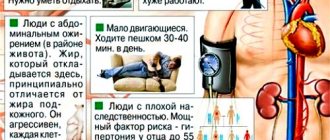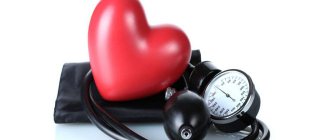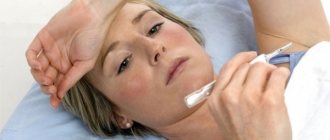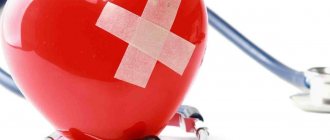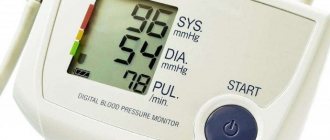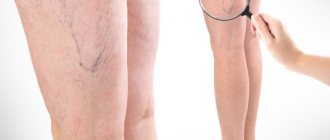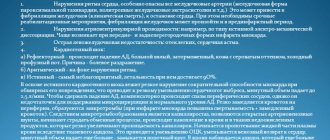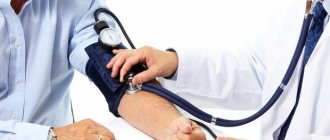Signs of high blood pressure and its threat to health
In a healthy person, 15-20 minutes after exercise, the pressure drops to normal values. If the elasticity of the vessels is reduced, or the lumen is clogged with cholesterol deposits, restoring blood flow is very difficult. The dangers of high blood pressure are as follows:
- The supply of blood to tissues and organs decreases, they experience a deficiency of oxygen and nutrients.
- With a critical increase in blood pressure, not only capillaries, but also arteries can burst: if this happens in the brain, paralysis, disruption of higher nervous activity, and even death are possible.
- The blood thickens and there is a tendency to thrombosis. If a blood clot blocks the narrowed lumen, cell death in the tissue occurs due to the cessation of oxygen supply.
People often ask: how to determine that blood pressure is increased (considering that normative values are often individual)? The main evidence is headache, pulsation in the temporal part. However, there are other characteristic symptoms of high blood pressure.
Feeling overtired
This is a neurotic syndrome reminiscent of a condition after physical labor or during a mild cold. A person becomes irritable, it is difficult for him to concentrate, he constantly wants to sleep during the day and cannot fall asleep at night, and redness of the eyeballs is often observed. The listed manifestations seem harmless to many, but they signal the initial degree of hypertension. In an adult, a similar condition usually occurs when blood pressure is 140/90, and in a child – already at 120/85 mm Hg. Art.
Headache
If the disease continues to worsen, the blood vessels begin to suffer from excess stress. First of all, cerebral circulation disorders appear, so hypertensive patients suffer from attacks of aching or squeezing headaches. In parallel, when checking the fundus at this stage, atrophic changes in the retina are diagnosed, indicating an increase in intraocular pressure. Similar symptoms of hypertension in combination with tonometer readings of 160/100 units. in adults or 130/100 in children are grounds for an urgent visit to a cardiologist and prescription of blood pressure medications.
Heartache
A person feels heaviness in the chest area, the heart begins to “ache,” tachycardia and arrhythmia appear. Sometimes painful “shots” radiate to the left arm. The described symptoms indicate that a systematic increase in blood pressure has led to pathological changes in the coronary vessels and heart muscle.
Hypertensive crisis
This combined syndrome is characteristic of stages 2-3 of hypertensive disease; it occurs when there is a sharp increase in pressure in the direction of increase. There are disturbances in the functioning of the heart, the pulse quickens, the body temperature rises, swelling appears, the limbs go numb, nausea and vomiting begin, and fainting is possible. If urgent measures are not taken, the patient faces death.
Important: External signs of a hypertensive crisis (HC) may include redness of the face, general overexcitement, increased sweating (sweat on the forehead), a feeling of lack of air, and shortness of breath. . Intracranial pressure
Intracranial pressure
The normative value of the pressure force of cerebrospinal fluid on brain tissue is 10-17 mm Hg. Art. With various pathologies of cerebral circulation, inflammatory processes, injuries, and intoxication, ICP increases. The symptoms of its rise are:
- intense pain of a pressing, pulsating and bursting nature, felt during rising after a night's sleep (localization area - temples, frontal and occipital parts);
- pain attacks in the neck area;
- nausea, vomiting;
- swelling around the eyes;
- blood pressure surges;
- rarefied pulse;
- deterioration of memory, concentration, and mental functions;
- “tunnel” vision, fog in the eyes, unclear contours of the image.
Reduced visual acuity with high intracranial pressure can lead to blindness.
Important: Specific signs of increased VD in infants are disproportionately rapid growth of the head, a convex fontanel, and the appearance of strabismus. In preschool and adolescence, headaches, fatigue, lethargy, increased reaction to bright light, and possibly strabismus are noted.
Hypertensive crisis
A frequent companion to hypertension of the second and third stages is a hypertensive crisis. In this state, there is a sharp increase in pressure upward. It develops rapidly and can last from several minutes to several hours. This happens at any age, but more often in the elderly.
A hypertensive crisis is very dangerous due to possible complications. There is a violation of blood circulation in the vessels that supply blood, oxygen and nutrients to the entire body. The kidneys, brain and heart are primarily affected.
The changes that occur in these organs cannot always be prevented and stopped, as a result of which life-threatening conditions develop: heart failure, stroke, myocardial infarction, renal failure, encephalopathy. Help in such situations must be provided immediately.
Symptoms of hypertension in a state of crisis:
- seizure;
- vomit;
- loss of consciousness;
- loss of vision;
- heartache;
- heart rhythm disturbance;
- feeling of fear and panic;
- severe shortness of breath;
- swelling;
- fever or chills;
- redness of the skin in the facial area:
- loss of sensation in the arms and legs;
- profuse sweating;
- trembling in hands.
Separately, you can add a few words about atypical forms of arterial hypertension.
If the systolic reading exceeds the normal level (above 140) and the diastolic reading is equal to normal or lower (less than 90), this phenomenon is called isolated systolic hypertension. This can most often be observed in elderly people. When systolic pressure corresponds to one degree, and diastolic pressure falls within another, higher readings are selected, and the stage of development of hypertension is determined from them.
Signs of high blood pressure
It is best for everyone to have a reliable pressure measuring device at home at all times. This recommendation is especially important for those over 40 years old. This way you can constantly monitor your blood pressure and quickly respond to high readings.
Besides this, there are other ways to find out that something is wrong in your body: you just need to pay attention to certain symptoms in time.
Doctors divided all the signs that a person feels with high blood pressure into three groups - neurotic, vegetative and fluid retention.
The first group includes:
- Increased fatigue.
- Dark spots before the eyes.
- Irritability.
- Dizziness.
- Severe pain in the back of the head.
- Noise in ears.
- Insomnia.
The appearance of these signs indicates the development of hypertension. In this case, you should measure blood pressure every day .
Symptoms and complications of hypertension
Vegetative signs appear:
- The appearance of redness on the face.
- Feeling of heaviness in the heart area.
- Increased sweating.
- Anxiety.
- Feeling of pulsation in the temples.
- Heartbeat disturbance.
These symptoms need to be responded to immediately, because they indicate a large jump in adrenaline in the blood. Thus, the body reacts to overexertion or strong experiences. These sensations may be a precursor to a hypertensive crisis.
The third type of symptoms is fluid retention, which can be recognized if :
- was detected .
- There was a tingling feeling.
- The feeling of numbness throughout the body haunts me
These symptoms indicate that a lot of fluid has entered the body, which does not have time to be eliminated from the body at a normal pace . Because of this, high pressure is felt in the blood vessels. In this case, doctors prescribe diuretics .
Useful video:
How does high blood pressure manifest in the elderly?
In old age, with high blood pressure, almost all of the above symptoms appear. This is a sign of wear and tear on the body.
The most common symptoms are headaches and dizziness. These symptoms are quite difficult for older people to overcome, but as soon as you get a little nervous, they begin to bother you again. Blood pressure reacts immediately to stress.
In addition, high blood pressure can be accompanied by chest pain, rapid heartbeat, and nausea.
In the presence of other serious diseases, these symptoms may appear even with the slightest surge in pressure.
Symptoms of hypertension in young and middle-aged people
If previously it was believed that high blood pressure was a disease of older people, now it is often found among young people.
In this age-old group, it arises due to improper lifestyle:
- Lack of sleep.
- Eating fast food.
- Working in an office, sitting for many hours at a desk in front of a computer.
- Excess weight.
- Experiments with drugs and nicotine, etc.
As a result, a person at 25 years old can suffer from high blood pressure just as painfully as a pensioner.
Characteristic signs of hypertension
It is impossible to recognize the development of hypertension from a woman externally. Diagnosis will require a comprehensive examination, but symptoms of high blood pressure will help prompt you to visit a doctor.
The main symptoms of high blood pressure in women:
- sleep disorders;
- prostration;
- soreness in the heart;
- dysfunction of the heart muscle;
- decreased appetite;
- numbness of the limbs;
- vestibular disorders;
- rapid fatigue;
- decreased performance;
- headaches.
The following signs indicate high blood pressure in women:
- involuntary muscle contraction;
- skin changes;
- gagging;
- clouding of consciousness;
- hyperhidrosis;
- deterioration of visual function.
Constant fatigue in a woman may be a sign of developing hypertension
Symptoms may appear immediately or increase gradually. Women do not immediately manage to recognize the first signs of oncoming hypertension, so they go to see a doctor with the disease already advanced.
Doctors recommend listening to the body and recording any changes. If signs of high blood pressure appear, you should not delay visiting a specialist. The longer you delay treatment for hypertension, the higher the likelihood of developing serious pathologies that affect the functioning of all internal organs.
A woman may not experience all the symptoms, but only some of them. The development of symptomatic manifestations is associated with the individual characteristics of the body, age, and other factors. Sometimes hypertension manifests itself only in a minor headache or a feeling of throbbing in the temples. Even minor signs should not be overlooked. During a hypertensive crisis, all perceptions become aggravated, the symptoms become pronounced, and immediate medical attention is required.
Three diseases that cause hypertension
It is generally accepted that hypertension is directly related to heart and vascular disease. And it is right. But there are three diseases that can have high blood pressure as a symptom and are in no way related to the heart. Some of them have already been mentioned above, but I would like to highlight them again more clearly. These are the diseases:
- adrenal tumor
- hyperthyroidism
- narrowing of the renal artery
1. Tumor of the adrenal glands. The first disease that causes catastrophically high pressure surges is adrenal tumor . The tumor produces hormones that we produce only under stress. And here she produces them constantly and in large quantities. The result is constant crises, while the heart and blood vessels are normal.
This is important to know, as it is often observed in young people. They have constant high upper blood pressure. During an attack, the pressure soars to 200-220 mm
Possible tachycardia. Heart rhythm disturbances up to myocardial infarction.
With such a picture, it is necessary to undergo an ultrasound examination, computed tomography, collect daily urine and check for the presence of stress hormones in it - catecholamines . Treatment is surgical removal of the tumor, which will immediately lead to normalization of blood pressure.
2. Hyperthyroidism. The second disease is associated with a functional malfunction of the thyroid gland. With hyperthyroidism, the gland begins to secrete a huge amount of hormones that stimulate the cardiovascular system. The release of blood increases due to the fact that the heart beats faster. The vessels do not dilate enough, and this leads to an increase in systolic (upper) pressure. It is necessary to undergo an ultrasound of the thyroid gland and check the presence of hormones in the blood.
3. Narrowing of the renal artery. The third disease is narrowing of the renal artery leading to hypertension in young people. Much less blood enters the kidney; it begins to produce substances that retain fluid and increase blood pressure. This type of hypertension is difficult to treat with medications.
The narrowing of the renal artery can be determined by ultrasound, then angiography is performed - a contrast X-ray method for examining the location of the narrowing of the artery. After this, a stand is used - dilation of the affected renal artery to normal diameter using a thin tube.
It is carefully inserted through a puncture in the thigh and approached to the affected artery. At the site of narrowing, the artery is inflated with a special balloon to its normal state.
The kidney receives sufficient blood supply and the pressure normalizes.
Therapy methods
Any form of hypertension must be treated. Lack of therapy provokes irreversible changes in all body systems. If a person’s blood pressure often rises, the treatment regimen is determined by the attending physician, based on the patient’s medical history and the presence of risk factors. Drug treatment includes taking drugs from the following pharmacological groups:
- Diuretics. Designed to remove excess fluid in the body.
- ACE inhibitors. Reduce the production of hormones that contribute to vasoconstriction.
- Beta blockers. Normalizes heart rate.
- Calcium antagonists. Helps relax blood vessels and stabilize blood pressure.
- Angiotensin-2 antagonists. They are an analogue of ACE inhibitors and act on a similar principle.
IMPORTANT!
To eliminate the symptoms of high blood pressure in women and men, they take drugs such as Sulfonamide, Carvedilol, Captopril. Sulfonamide is a strong diuretic that is used for resistant forms of hypertension. It is taken for diabetes mellitus, as it affects blood glucose levels. Sulfonamide is excreted by the liver and kidneys without accumulating in the body. Included in the pharmaceutical preparations Ravel SR, Acripamide, Ionic.
Contraindications: lactose intolerance, low potassium levels in the blood, acute renal and liver failure, pregnancy and breastfeeding. Side effects: urticaria, abdominal pain, nausea, vomiting, diarrhea, runny nose, dizziness, nervous disorders and heart rhythm disturbances.
Other medications
The drug Carvedilol blocks beta and alpha1 receptors, affecting lipid metabolism, the level of potassium, sodium and magnesium compounds in the blood plasma. Contraindications for use: obstructive pulmonary diseases, liver failure, bradycardia, sinus node syndrome, pulmonary hypertension.
Captopril belongs to the group of ACE inhibitors, intended to combat hypertensive crisis. It is not recommended for elderly patients diagnosed with cerebral atherosclerosis. Contraindications:
- pregnancy;
- lactation;
- age restrictions (from 18 years);
- kidney transplant;
- circulatory disorders;
- cerebral ischemia;
- diabetes;
- autoimmune diseases.
The drug Amlodipine is a calcium blocker that increases exercise tolerance. Eliminates the need to use diuretics. Indicated for elderly patients (with cerebral atherosclerosis and angina pectoris). Contraindications: pregnancy, age restrictions. Not recommended for use in case of liver failure.
ethnoscience
If you have high blood pressure, you can take folk remedies after consulting with your therapist. Tincture of fir cones helps restore the walls of blood vessels and reduce the risk of blood clots. Tannin and bioflavonoids, which are part of red pine cones, stop the clumping of blood cells, having a blood-thinning effect.
Flaxseeds are enriched with omega 3 acids, so they reduce cholesterol levels by restoring blood vessels. Garlic prevents the formation of atherosclerotic plaques, quickly stabilizing blood pressure.
Along with medication and alternative treatment, it is recommended:
- give up bad habits (smoking, alcohol abuse, sweet, salty or fatty foods);
- Maintain a balance between physical and intellectual activity; regular exercise has a positive effect on the condition of blood vessels.
Particular attention is paid to the diet, from which foods that increase blood pressure are excluded:
- By-products - liver, brains.
- Smoked, salted, hot and spicy dishes.
- Fatty fish or meat.
- Whole dairy products and hard cheeses.
- Confectionery and sweet bakery products.
Treatment
Before prescribing treatment, the doctor must conduct an examination. This is necessary to identify the cause of high blood pressure in women, determine the degree of hypertension, if any, and detect concomitant diseases.
If hypertension is detected, you will need to constantly take medications. For high blood pressure, the following groups of drugs are used:
- ACE inhibitors.
- Diuretics.
- Adrenergic blockers.
- Calcium antagonists.
Only the attending physician selects the appropriate medicine for each patient, determines the optimal dosage and frequency of administration. Self-medication is strictly prohibited.
If a hypertensive crisis occurs, the patient may be prescribed injections. With the help of injections it is possible to quickly stabilize blood pressure. They are not used for the permanent treatment of hypertension; their purpose is to urgently lower blood pressure. Therefore, they are not even freely available in pharmacies for sale to people.
Depending on the severity, comprehensive treatment for high blood pressure is selected
In addition to medications, it is important for patients to adjust their diet. It is necessary to remove from the diet all foods that increase blood pressure and cause harm to the body, for example, fast food, smoked meats, sausages, canned food, fatty and fried foods.
You also need to limit your salt intake. You are allowed to consume no more than 5 g per day. The diet should be enriched with vegetables, fruits, nuts, legumes, buckwheat, and oatmeal. As for meat, you should give preference to chicken.
Patients with high blood pressure should not forget about sports. An increase in blood pressure is not a reason to refuse physical activity, it just needs to be moderate and not involve lifting heavy objects or making sudden movements. Doctors advise running, swimming, cycling, and performing therapeutic and breathing exercises.
Increased eye pressure, causes and symptoms
People with problematic cardiovascular systems and hereditary predisposition most often suffer from this pathology. Main reasons:
- poor psycho-emotional background, excitability
- excessive eye strain
- high blood pressure
- chronic kidney disease
- cardiovascular pathologies
- thyroid disease
The peculiarity of the pathology is the complete absence of symptoms. Only an ophthalmologist can detect the disease. As the disease progresses, a person develops the following symptoms:
- migraine, constant pain in the eyes, heaviness, fatigue, pain in the temples
- sharp decrease in vision, blurred vision, spots
- loss of vision at dusk, peripheral vision, visual field
If symptoms appear, the causes of this condition should be eliminated. And seek help from a doctor. In the early stages, this includes eye exercises, eye drops to drain fluid, and wearing special glasses. Next, complex treatment is carried out. If drug treatment is ineffective, laser treatment or microsurgical treatment is used.
The danger of increased eye pressure is the occurrence of glaucoma, death of the optic nerve, blindness.
Causes of pathology
According to statistics, in 1-5% of cases the causes of high blood pressure in women are associated with other diseases:
- diseases of the kidneys and adrenal glands: chronic pyelonephritis, glomerulonephritis, diabetic nephropathy, polycystic disease, tumors, congenital anomalies of the organ;
- endocrine pathologies: damage to the cortex and medulla of the adrenal glands, malfunctions of the thyroid gland, parathyroid gland, pituitary gland;
- hemodynamic disorders: arterial damage, atherosclerosis;
- neurological diseases: increased intracranial pressure, tumors, brain injuries, meningitis, encephalitis;
- taking medications: hormonal contraceptives, glucocorticosteroids, mineralocorticoids, non-steroidal anti-inflammatory drugs;
- back diseases: osteochondrosis or untreated injuries that create constant tension in the muscles of the back and neck, which leads to vasospasm, which disrupts the nutrition of the brain.
In such cases, there is constantly high blood pressure, which does not decrease in the usual ways.
Adjustable
There are risk factors that can be changed. An increase in blood pressure is observed with poor nutrition (the presence of salty, fatty, spicy foods in the diet), excess weight, smoking, and lack of physical activity.
The reasons for a sharp increase in blood pressure include: stressful situations (especially in women), lack of sleep, overwork, weather changes, drinking alcohol or a cup of strong coffee.
Unregulated
Unregulated (unchangeable) risk factors include a person’s age (in older people the risk of hypertension is much higher than in young people), and hereditary predisposition.
The cause of high blood pressure is hormonal imbalances that occur in women after 40 years of age (menopause), during puberty. The prevalence of arterial hypertension during pregnancy is 5-20%.
The pathology develops as a result of increased stress on the cardiovascular system due to: increased metabolic processes, increased volume of circulating blood, weight gain, and other factors. The critical blood pressure level in pregnant women is 170/100, which is an indication for hospitalization. At the same time, the blood vessels narrow, the blood supply to all important organs, including the placenta, is disrupted, and fetal development slows down. There is a threat of preeclampsia and eclampsia.
Periodic increase in pressure
If elevated blood pressure is periodically recorded in a patient, this may be a manifestation of one of the following conditions:
- cardiopsychoneurosis;
- mild degree of hypertension (not a stage!).
In these cases, it is necessary to modify your lifestyle: avoid stress and excessive loads, engage in regular aerobic exercise, give up cigarettes and alcohol, consume less salt (at least do not add salt to the food on your plate and do not eat canned food, smoked meats and other salty foods). At the same time, it is recommended to monitor blood pressure independently using a tonometer at least once a week, and preferably more often. Additionally, you can take herbal sedatives, for example, motherwort.
If blood pressure has not returned to normal within a month, you should consult a physician and undergo an examination. It should include an electrocardiogram, preferably 24-hour blood pressure monitoring; blood and urine tests, including biochemical tests, examination by a neurologist and ophthalmologist (to detect vascular changes in the fundus).
If it is already known that the patient has hypertension, but the pressure still rises, it is necessary to select a combination of medications that will keep it at the desired level.
What to do with high blood pressure in case of hypertensive crisis? First of all, ensure physical and mental rest for the patient. You can take a sedative, as well as one of the medications that can quickly lower blood pressure (captopril, nifedipine or others). You should ask your doctor in advance about which drug to take in this case.
If there is no effect within an hour or the condition worsens, you should contact an ambulance.
If blood pressure has risen in a pregnant woman, but it is below the numbers that indicate preeclampsia, this is probably a sign of OPG-preeclampsia . This is a complication of the second half of pregnancy, accompanied by edema, protein excretion in the urine and hypertension. OPG gestosis often requires hospital treatment. Self-medication is unacceptable, since many drugs for lowering blood pressure during pregnancy are contraindicated.
Risk groups for high blood pressure. How to protect yourself from hypertension
The first risk group is people with increased weight . There is an interesting connection between waist size and hypertension. For women, the waist should be 88 cm or less, for men - 94 cm or less. If your waist size is larger, your blood pressure increases.
When you lose weight, your blood pressure will also decrease, and without the use of drugs - up to 20 units. If you do not bring your weight back to normal, there is an almost 100% chance of death from a stroke or heart attack.
2. The second risk group is people who eat salt . Salt retains fluid in the body and prevents its elimination. Once in the blood vessels, salt increases the volume of blood in the body, which causes hypertension. Limiting salt intake reduces blood pressure by 5-7 mmHg.
In all international protocols, in all official recommendations for hypertensive patients, salt abolition is the first dietary recommendation. Moreover, by adhering to this recommendation, you can lose weight from 6 to 12 kg - just by eliminating salt. Overweight people who consume salt have a lot of excess fluid in their bodies.
The only thing: I am against eliminating salt consumption completely, but reducing it to a minimum is normal.
What pressure is considered normal?
To prevent complications that arise from high blood pressure, it is recommended to monitor changes in indicators, and if they deviate from the norm, consult a doctor. The guidelines set to determine the normal level of pressure show the maximum limits of indicators, depending on the age group. So, blood pressure is considered normal:
| Age | Bottom line | Upper limit |
| Children | ||
| 0-2 weeks | 60/40 | 96/50 |
| 2-4 weeks | 80/40 | 112/74 |
| From 1 month to 1 year | 90/50 | 112/74 |
| 2-3 years | 100/60 | 112/74 |
| 4-5 | 100/60 | 116/76 |
| 6-10 | 100/60 | 122/78 |
| Teenagers | ||
| 11-12 | 110/70 | 126/82 |
| 13-15 | 110/70 | 136/86 |
| 16-20 | 116/72 | 123/76 |
| Adults | ||
| 30 | 120/75 | 126/79 |
| 40 | 127/80 | 129/81 |
| 50 | 135/83 | 135/84 |
| 60-65 | 135/85 | 140/90 |
| Elderly people | ||
| Over 65 | 135/89 | 150/90 |
Symptoms
In recent years, hypertension has become much younger. In case of constant stress, neuroses, sedentary life, smoking, this disease affects young people and even children.
For high blood pressure, the symptoms are:
- overwork;
- headache;
- pain in the heart area;
- hypertensive crisis.
Let's look at each of the symptoms presented in more detail.
Overwork
The first signal that you have high blood pressure is a condition that resembles overwork or a mild cold. The following symptoms occur:
- a certain irritability
- daytime sleepiness
- sleep disturbances at night,
- inability to concentrate
- redness of the eyeballs.
Most people do not take such manifestations seriously, although it is completely in vain. After all, if blood pressure at rest is 140/90 mm Hg in adults. Art. and in children 120/90 mm Hg. Art., and there is also a tendency to a subsequent increase, then we can say about a mild form of hypertensive disease.
All men over 40 years of age (according to statistics, the development of hypertension in men is several times more common than in women), as well as people at risk (overweight, diabetics) are required to regularly measure blood pressure.
Classification of forms of arterial hypertension
Headache
When further development of the disease is observed, hypertensive patients begin to experience headaches of aching and also squeezing nature. Along with this symptom, ophthalmologists can diagnose changes in the fundus and the presence of atrophic processes in the retina.
The presented manifestations may indicate that there is increased intraocular pressure. Such a disorder can be a signal for the appearance of serious vision diseases.
When the resting blood pressure in adults is 160/100 mm Hg. Art., and in children 130/100 mm Hg. Art., then you need to urgently go to a cardiologist and take special antihypertensive drugs. Such blood pressure indicators pose a health hazard.
Pain in the heart area
In combination with headaches, patients with high blood pressure complain of painful attacks in the left side of the chest. The presented pain sensations can radiate to the left arm and disrupt the rhythm of the heart.
The presented symptoms may indicate that high blood pressure contributed to the formation of pathological changes in the coronary arteries and heart muscle. This should include:
- coronary heart disease,
- angina pectoris;
- enlargement of the left ventricle, accompanied by a decrease in cardiac output and the formation of heart failure.
Risk factors for developing arterial hypertension
High blood pressure in young women, as well as in old age, can develop against the background of internal changes occurring in the body:
- kidney failure;
- hormonal changes during menopause;
- passive lifestyle;
- diabetes;
- brain concussion;
- bad habits;
- gestation period;
- excess body weight;
- use of medications that affect blood pressure;
- diseases of the heart and blood vessels.
Women with these problems are at risk of developing arterial hypertension and should regularly monitor their levels.
What to do with high blood pressure
It is worth knowing everything about high blood pressure in a person; treatment cannot be delayed so as not to cause a hypertensive crisis. If it occurs, immediately seek medical help.
You can cure high blood pressure at home by following these recommendations:
- Prepare a hot bath to warm your feet. You need to lie down correctly and relax with high blood pressure. The duration of the procedure should not exceed 15 minutes. During this time, the blood vessels will dilate and your health will improve.
- You can put mustard plaster on the top of your head. Keep it for 20 minutes.
- If you have high blood pressure, you should make a compress with apple cider vinegar. To do this, soak a clean towel in vinegar and place it on your feet. Duration of the procedure – 20 minutes;
- If your blood pressure is high, it is recommended to start doing breathing exercises. Sit on a chair, calm down and take 5 deep breaths. Then do the procedure 6 times with your nose and 5 times with your mouth. Finally, combine inhalation through your nose and exhalation through your mouth.
- For high blood pressure, doctors often prescribe various medications. For example, Cyclomethiazide, Cariol, Indapamide. The following drugs can also prevent hypertension - Lisinoton, Perineva, Teveten, Diacordin. If there is a strong threat of further development of the disease, you should not refuse treatment in a hospital. If the disease is neglected, coronary syndrome and cerebrovascular accident may occur.
If you have high blood pressure, it is recommended to know how to lie down and relax correctly. To do this, you should place your head on a large pillow, after opening all the windows in the room so that there is access to fresh air.
Prevention measures
There are no special preventive measures to reduce the risk of developing hypertension, since many factors influence the increase in blood pressure. But there are general recommendations that, if followed, will help minimize the risk of developing hypertension:
- maintaining a healthy lifestyle;
- rejection of bad habits;
- complete nutrition;
- normal sleep and wakefulness patterns.
The main reason for high blood pressure is stress. Blood pressure fluctuates due to psycho-emotional stress. To reduce the risk of developing hypertension, it is necessary to reduce the stress on the nervous system:
- reduce the impact of stress;
- do yoga or breathing techniques;
- sleep and rest more;
- learn to relax;
- Take mild sedatives for severe anxiety.
If your blood pressure is high, you should immediately consult a doctor. High blood pressure in women requires mandatory correction.
How to get rid of high blood pressure at home
With a slight increase in pressure, traditional methods of treatment can be effective. What to do with high blood pressure at home is determined by the capabilities and condition of the patient.
Garlic
The most effective method of treatment is to use simple garlic - this product will be effective for reducing blood pressure both fresh and in the form of pickles or tinctures. The main thing is to use it regularly.
You can also eat garlic with sugar (20 g and 100 g, respectively). The mixture is made simply: the composition is poured with boiling water and infused for at least 6 hours. The solution is taken one tablespoon before meals. You can eat a whole clove of garlic at the same time, eating bread.
You can also grind a small lemon with 5 cloves of garlic and 100 g of honey. The mixture is infused for a week in a dark, warm place, and subsequently stored in a cool place. Take a teaspoon three times a day.
You can also chop a couple of cloves of garlic, add water and leave overnight. In the morning, the solution is drunk on an empty stomach, and a new one is immediately prepared for the evening.
Note. The course of treatment with garlic is a month
Garlic with honey is a good remedy for blood pressure
Fresh vegetable juices
Many people notice the effect of mixing freshly squeezed vegetable juices. The juices of carrots, parsley, spinach and celery are mixed in a ratio of 7 to 2 to 3 to 4, respectively. Four times a day you need to drink a liter before meals.
You can also mix beetroot juice with honey in equal proportions and take 3 tablespoons of the mixture when your blood pressure rises. You can add lemon juice to the mixture.
If there are no ulcers in the gastrointestinal tract, you can drink 50 ml of chokeberry juice, dividing the volume into 3 doses. The course of application is a month.
Golden mustache
The crushed golden mustache is filled with a sufficient amount of alcohol (vodka), tightly closed with a lid and infused for 12 days. To lower blood pressure, take the tincture on an empty stomach, 1 small spoon per day. The course of admission is one month.
Hawthorn and rosehip
To lower the pressure (especially with a high upper reading), you can mix 4 volumes of hawthorn, half as much dill and 3 volumes of rowan. The entire mixture is poured into a thermos (it is enough to take 3 tablespoons of fruit per liter of water) and kept for 2-3 hours. The finished decoction is drunk once a day (1 glass per use).
Decoctions
A decoction of valerian root helps against high blood pressure - 10 g of the substance is boiled for 15 minutes over low heat. The decoction is taken 4 times a day, a tablespoon. The solution cannot be kept for more than a day, even in the refrigerator.
A decoction of dill seeds helps - 4 tablespoons per liter of water. The solution is infused for 3 hours. Take ¾ of a regular glass once a day.
To lower blood pressure, you can also drink one tablespoon a day of one of the following decoctions:
- peony tincture (eliminates spasms and tone);
- hawthorn (lowers the tone of the heart walls, reduces excitability);
- motherwort tincture increases the strength of heart contractions;
- valerian extract (lowers blood pressure, inhibits and relaxes the central nervous system);
- An infusion of pine cones brings blood pressure back to normal and stabilizes it.
Note. Drinking coconut water, almonds, ginger, turmeric, beans, spinach, bananas and green tea can also help lower blood pressure. You can effectively lower your blood pressure by eating dark chocolate, viburnum, rowan berries, beets, carrots, and cucumbers. It is useful to drink flaxseed oil or seed.
Other treatments
You can make a hot bath for your feet - water is poured into a basin at the maximum temperature that can be tolerated. You can steam your feet for no more than 10 minutes.
You can also apply a compress of apple cider vinegar to your feet. The duration of the procedure is 15-20 minutes. This will cause blood to flow away from the head.
The doctor will decide whether it is possible to do a massage to relieve an attack. In any case, the procedure must be carried out by a trained massage therapist.
Note. Consuming coconut water, almonds, ginger, turmeric, beans, spinach, bananas and green tea also helps lower blood pressure.
can be avoided if you start treating high blood pressure on time
